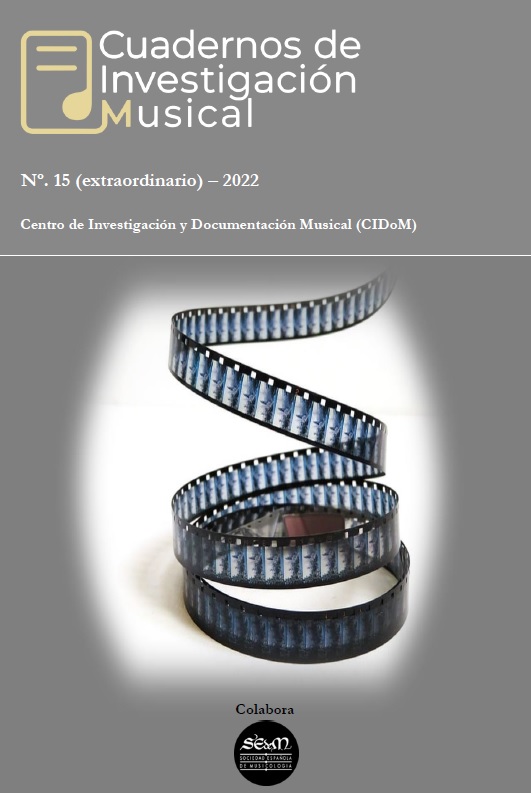Los vídeos musicales de Madonna como performances audiovisuales
Cuarenta años de cultura popular
DOI:
https://doi.org/10.18239/invesmusic.2022.15.13Palabras clave:
Pedagogía, Educación, Performatividad, Música pop, Cultura popResumen
En los últimos años, el concepto de performance ha adquirido un valor cada vez más específico en referencia a las cuestiones de educación, evaluación y percepción. Es una palabra que hace referencia no solo a las actuaciones que llevamos a cabo en caso necesario, sino también al mundo del espectáculo, donde la música y la visión se combinan para generar eventos sensacionales y la magia de la ficción. En Society of the Spectacle, escrito por Guy Debord en 1967, el autor afirmaba que el espectáculo se ha convertido en “parte integrante de nuestra propia existencia”: este hecho era cierto en su momento y lo sigue siendo hoy. Sin embargo, en la era visual contemporánea, estamos hiperconectados y transformados en “imágenes sonoras” proyectadas en nuestras pantallas, faltando nuestra parte humana-relacional. La carrera de Madonna Louise Veronica Ciccone comenzó a principios de los años 80 del siglo XX y aún no ha terminado. Durante estos cuarenta años, Madonna ha construido una innovadora “poética de la performance”, estudiada por muchos sociólogos a nivel internacional.
Referencias
Baroncini E. (1987). Madonna. Milan: Forte.
Bauman, Z. (2000). Liquid Modernity. Oxford: Malden-Blackwell.
Bauman, Z. (2008). Vite di corsa. Come salvarsi dalla tirannia dell’effimero. Bologna: Il Mulino.
Berton, L. (2007). Videoclip. Storia del video musicale dal primo film sonoro all’era di You-Tube. Milan: Mondadori.
Calefato, P. (1999). Moda, corpo, mito. Storia, mitologia e ossessione del corpo vestito. Rome: Castelvecchi.
Corsi M. (2003). Il coraggio di educare. Il valore della testimonianza. Milan: Vita e Pensiero.
Debord, G. (1967). Society of the Spectacle. London: Rebel Press.
Gay, V. P. (1992). Freud on sublimation. Reconsiderations. Albany: State University of New York Press.
Giliberti, E. (2002). Madonna. Come si costruisce un corpo-citazione. In M. Baroni (Ed.), Streghe, madonne e sante postmoderne. Eccedenze femminili tra cronaca e fiction (pp. 49-66). Rome: Meltemi.
Guilbert, G.-C. (2002). Madonna as Postmodern Myth. How One Star’s Self-Construction Rewrites Sex, Gender, Hollywood, and the American Dream. Jefferson-London: McFarland & Company.
Hernwall, P. (2009). The Space of the Body-Self. Construction of Gender Identities Online, in F. Deriu, L. Esposito & A. Ruggiero (Eds), Metropoli e nuovi consumi culturali. Performance urbane dell’identità (pp. 177-195). Roma: Carocci.
Hofstede, G. H. (2010). Cultures and organizations: software of the mind. Intercultural cooperation and its importance for survival. New York: McGraw-Hill.
Kaplan E. A. (1993). Madonna Politics: Perversion, Repression, or Subversion? Or Masks and/as Master-y. In C. Schwichtenber (Ed.), Madonna Connection. Representational Politics, Subcultural Identities, and Cultural Theory (pp. 149-165). St Leonards: Allen & Unwin.
Levitin, D. J. (2008). Il mondo in sei canzoni. Come il cervello musicale ha creato la natura umana. Turin: Codice.
Liggeri, D. (2006). Musica per i nostri occhi. Storie e segreti dei videoclip. Milan: Bompiani.
Macrì, T. (1996). Il corpo postorganico. Milan: Costa & Nolan.
McGuire, W. (1974). Lettere tra Freud e Jung (1906-1913). Turin: Bollati Boringhieri.
Schechner, R. (1984). La teoria della performance. 1970-1983. Rome: Bulzoni.
Schechner, R. (2013). Performance studies. An introduction. London: Routledge.
Sibilla, G. (2005). I linguaggi della musica pop. Milan: Bompiani.
Stramaglia, M. (2015). Love is music. Adolescents and the world of spectacle. Saarbrücken: EAI.
Tancredi, P. (1999). Sfumature di nero nei video di Madonna. In S. Petrilli (Ed.). Nero (pp. 129-136). Lecce: Piero Manni.
Turner, V. (1982). From Ritual to Theatre. The Human Seriousness of Play. New York: PAJ Publications.
Turner, V. (1986). Antropology of Performance. New York: PAJ Publications.
Van den Berg M. & Ter Hoeven, C. L. (2013). Madonna as a symbol of reflexive modernisation. Celebrity Studies, 4 (2), pp. 144-154.
Viñuela E. (2018). Bitch She’s Madonna. La Reina del Pop en la Cultura Contemporánea. España: Dos Bigotes.
Publicado
Número
Sección
Licencia
Los autores de los artículos mantienen el copyright, no recibirán ninguna contraprestación económica por el trabajo y el mismo siempre será reconocido como exclusivamente suyo. La revista se compromete a proteger la integridad y originalidad del artículo, así como los derechos de autor que correspondan. Los autores son los únicos responsables del material, textos e imágenes que utilizan en sus respectivos trabajos, debiendo respetar siempre los derechos de autor de terceras personas, por lo que la revista no se hace responsable de lo contenido en este tema respecto al trabajo de los autores.


